COU101A - Reflective Essay: Communication Skills and Relationships
VerifiedAdded on 2023/06/04
|8
|2317
|445
Essay
AI Summary
This essay reflects on the importance of interpersonal communication skills in both personal and professional relationships, drawing on personal experiences and observations. It emphasizes that communication is the exchange of information, ideas, and thoughts between individuals and is crucial for maintaining healthy relationships. The essay discusses the role of effective communication in resolving conflicts, building trust, and fostering mutual understanding. It also addresses barriers to communication, such as jargon, emotional barriers, and physical disabilities, and suggests strategies for overcoming these barriers, including active listening, empathy, and clear articulation. The author shares personal experiences to illustrate the significance of assertive communication and the impact of communication styles on workplace dynamics. The essay concludes that effective communication is the foundation of any relationship and requires open-mindedness, attentive listening, and appropriate responses.
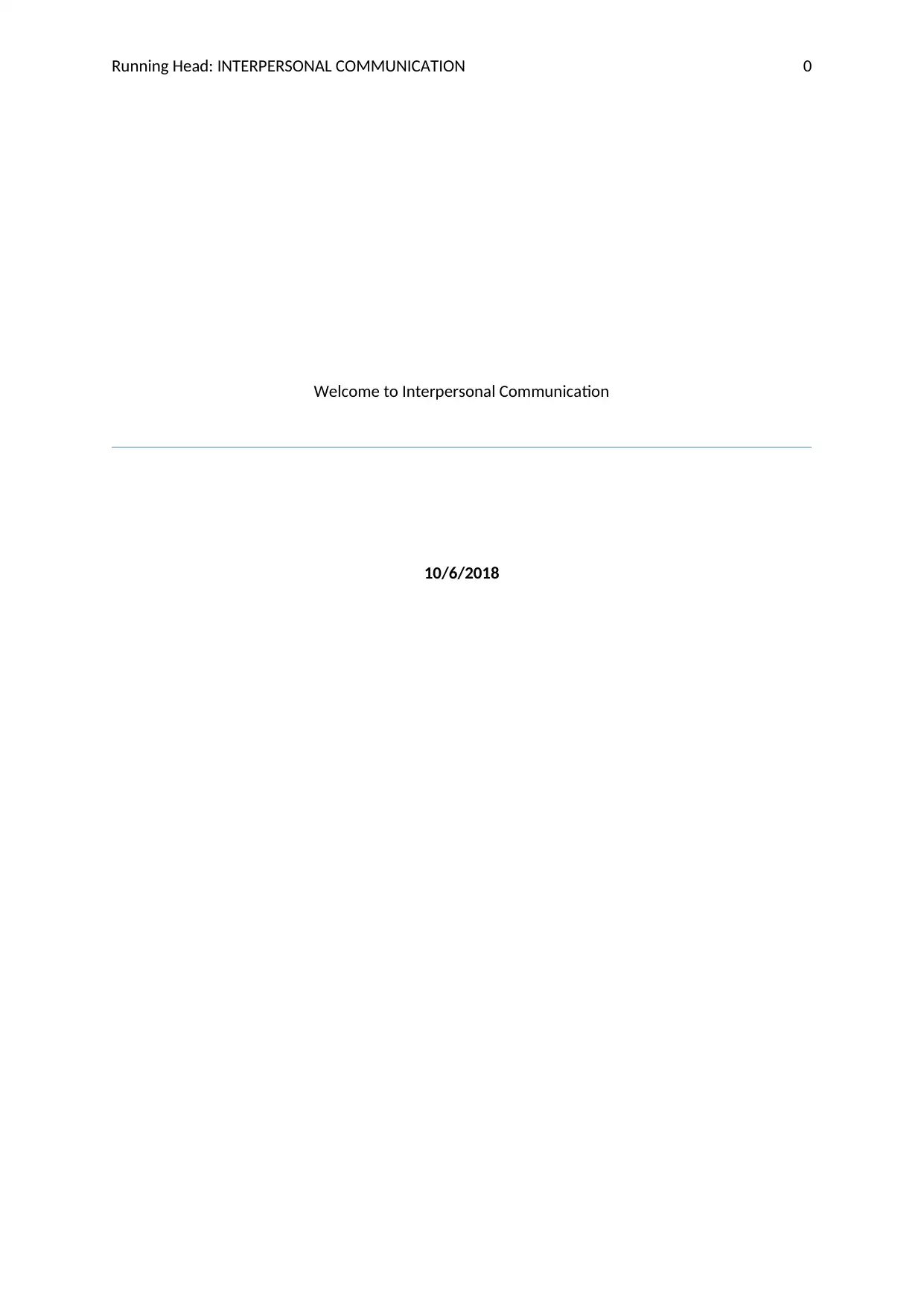
Running Head: INTERPERSONAL COMMUNICATION 0
Welcome to Interpersonal Communication
10/6/2018
Welcome to Interpersonal Communication
10/6/2018
Paraphrase This Document
Need a fresh take? Get an instant paraphrase of this document with our AI Paraphraser
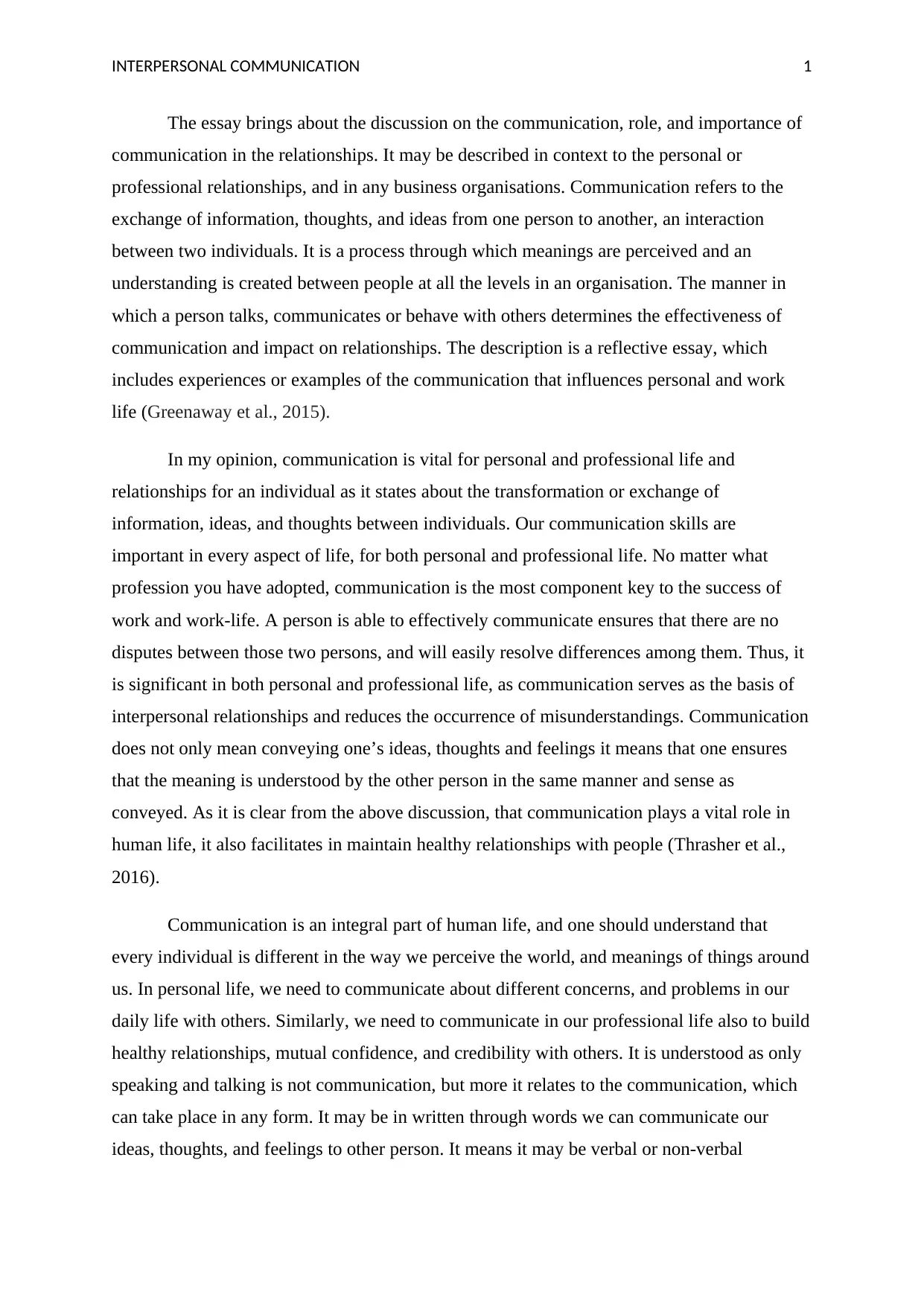
INTERPERSONAL COMMUNICATION 1
The essay brings about the discussion on the communication, role, and importance of
communication in the relationships. It may be described in context to the personal or
professional relationships, and in any business organisations. Communication refers to the
exchange of information, thoughts, and ideas from one person to another, an interaction
between two individuals. It is a process through which meanings are perceived and an
understanding is created between people at all the levels in an organisation. The manner in
which a person talks, communicates or behave with others determines the effectiveness of
communication and impact on relationships. The description is a reflective essay, which
includes experiences or examples of the communication that influences personal and work
life (Greenaway et al., 2015).
In my opinion, communication is vital for personal and professional life and
relationships for an individual as it states about the transformation or exchange of
information, ideas, and thoughts between individuals. Our communication skills are
important in every aspect of life, for both personal and professional life. No matter what
profession you have adopted, communication is the most component key to the success of
work and work-life. A person is able to effectively communicate ensures that there are no
disputes between those two persons, and will easily resolve differences among them. Thus, it
is significant in both personal and professional life, as communication serves as the basis of
interpersonal relationships and reduces the occurrence of misunderstandings. Communication
does not only mean conveying one’s ideas, thoughts and feelings it means that one ensures
that the meaning is understood by the other person in the same manner and sense as
conveyed. As it is clear from the above discussion, that communication plays a vital role in
human life, it also facilitates in maintain healthy relationships with people (Thrasher et al.,
2016).
Communication is an integral part of human life, and one should understand that
every individual is different in the way we perceive the world, and meanings of things around
us. In personal life, we need to communicate about different concerns, and problems in our
daily life with others. Similarly, we need to communicate in our professional life also to build
healthy relationships, mutual confidence, and credibility with others. It is understood as only
speaking and talking is not communication, but more it relates to the communication, which
can take place in any form. It may be in written through words we can communicate our
ideas, thoughts, and feelings to other person. It means it may be verbal or non-verbal
The essay brings about the discussion on the communication, role, and importance of
communication in the relationships. It may be described in context to the personal or
professional relationships, and in any business organisations. Communication refers to the
exchange of information, thoughts, and ideas from one person to another, an interaction
between two individuals. It is a process through which meanings are perceived and an
understanding is created between people at all the levels in an organisation. The manner in
which a person talks, communicates or behave with others determines the effectiveness of
communication and impact on relationships. The description is a reflective essay, which
includes experiences or examples of the communication that influences personal and work
life (Greenaway et al., 2015).
In my opinion, communication is vital for personal and professional life and
relationships for an individual as it states about the transformation or exchange of
information, ideas, and thoughts between individuals. Our communication skills are
important in every aspect of life, for both personal and professional life. No matter what
profession you have adopted, communication is the most component key to the success of
work and work-life. A person is able to effectively communicate ensures that there are no
disputes between those two persons, and will easily resolve differences among them. Thus, it
is significant in both personal and professional life, as communication serves as the basis of
interpersonal relationships and reduces the occurrence of misunderstandings. Communication
does not only mean conveying one’s ideas, thoughts and feelings it means that one ensures
that the meaning is understood by the other person in the same manner and sense as
conveyed. As it is clear from the above discussion, that communication plays a vital role in
human life, it also facilitates in maintain healthy relationships with people (Thrasher et al.,
2016).
Communication is an integral part of human life, and one should understand that
every individual is different in the way we perceive the world, and meanings of things around
us. In personal life, we need to communicate about different concerns, and problems in our
daily life with others. Similarly, we need to communicate in our professional life also to build
healthy relationships, mutual confidence, and credibility with others. It is understood as only
speaking and talking is not communication, but more it relates to the communication, which
can take place in any form. It may be in written through words we can communicate our
ideas, thoughts, and feelings to other person. It means it may be verbal or non-verbal
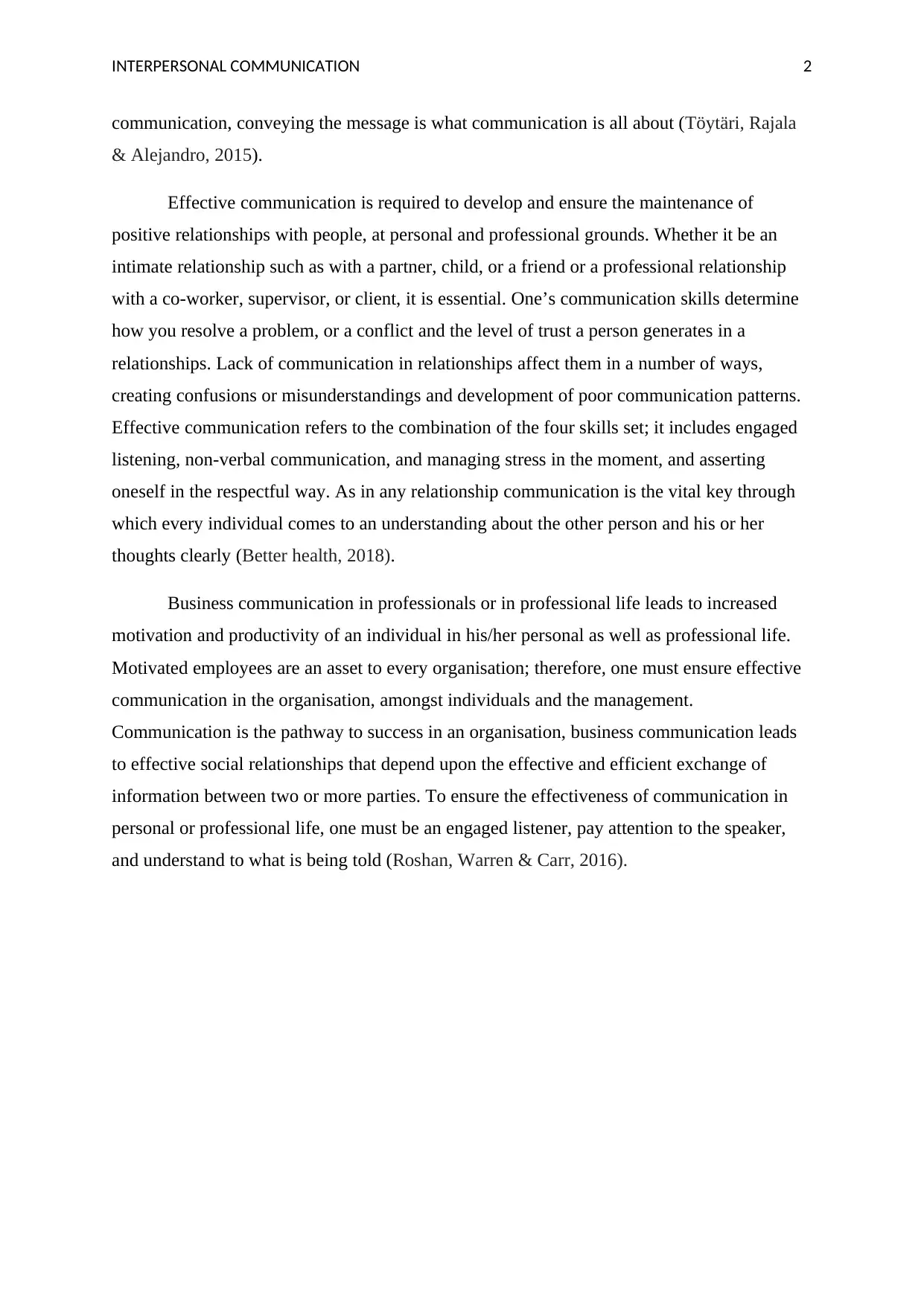
INTERPERSONAL COMMUNICATION 2
communication, conveying the message is what communication is all about (Töytäri, Rajala
& Alejandro, 2015).
Effective communication is required to develop and ensure the maintenance of
positive relationships with people, at personal and professional grounds. Whether it be an
intimate relationship such as with a partner, child, or a friend or a professional relationship
with a co-worker, supervisor, or client, it is essential. One’s communication skills determine
how you resolve a problem, or a conflict and the level of trust a person generates in a
relationships. Lack of communication in relationships affect them in a number of ways,
creating confusions or misunderstandings and development of poor communication patterns.
Effective communication refers to the combination of the four skills set; it includes engaged
listening, non-verbal communication, and managing stress in the moment, and asserting
oneself in the respectful way. As in any relationship communication is the vital key through
which every individual comes to an understanding about the other person and his or her
thoughts clearly (Better health, 2018).
Business communication in professionals or in professional life leads to increased
motivation and productivity of an individual in his/her personal as well as professional life.
Motivated employees are an asset to every organisation; therefore, one must ensure effective
communication in the organisation, amongst individuals and the management.
Communication is the pathway to success in an organisation, business communication leads
to effective social relationships that depend upon the effective and efficient exchange of
information between two or more parties. To ensure the effectiveness of communication in
personal or professional life, one must be an engaged listener, pay attention to the speaker,
and understand to what is being told (Roshan, Warren & Carr, 2016).
communication, conveying the message is what communication is all about (Töytäri, Rajala
& Alejandro, 2015).
Effective communication is required to develop and ensure the maintenance of
positive relationships with people, at personal and professional grounds. Whether it be an
intimate relationship such as with a partner, child, or a friend or a professional relationship
with a co-worker, supervisor, or client, it is essential. One’s communication skills determine
how you resolve a problem, or a conflict and the level of trust a person generates in a
relationships. Lack of communication in relationships affect them in a number of ways,
creating confusions or misunderstandings and development of poor communication patterns.
Effective communication refers to the combination of the four skills set; it includes engaged
listening, non-verbal communication, and managing stress in the moment, and asserting
oneself in the respectful way. As in any relationship communication is the vital key through
which every individual comes to an understanding about the other person and his or her
thoughts clearly (Better health, 2018).
Business communication in professionals or in professional life leads to increased
motivation and productivity of an individual in his/her personal as well as professional life.
Motivated employees are an asset to every organisation; therefore, one must ensure effective
communication in the organisation, amongst individuals and the management.
Communication is the pathway to success in an organisation, business communication leads
to effective social relationships that depend upon the effective and efficient exchange of
information between two or more parties. To ensure the effectiveness of communication in
personal or professional life, one must be an engaged listener, pay attention to the speaker,
and understand to what is being told (Roshan, Warren & Carr, 2016).
⊘ This is a preview!⊘
Do you want full access?
Subscribe today to unlock all pages.

Trusted by 1+ million students worldwide
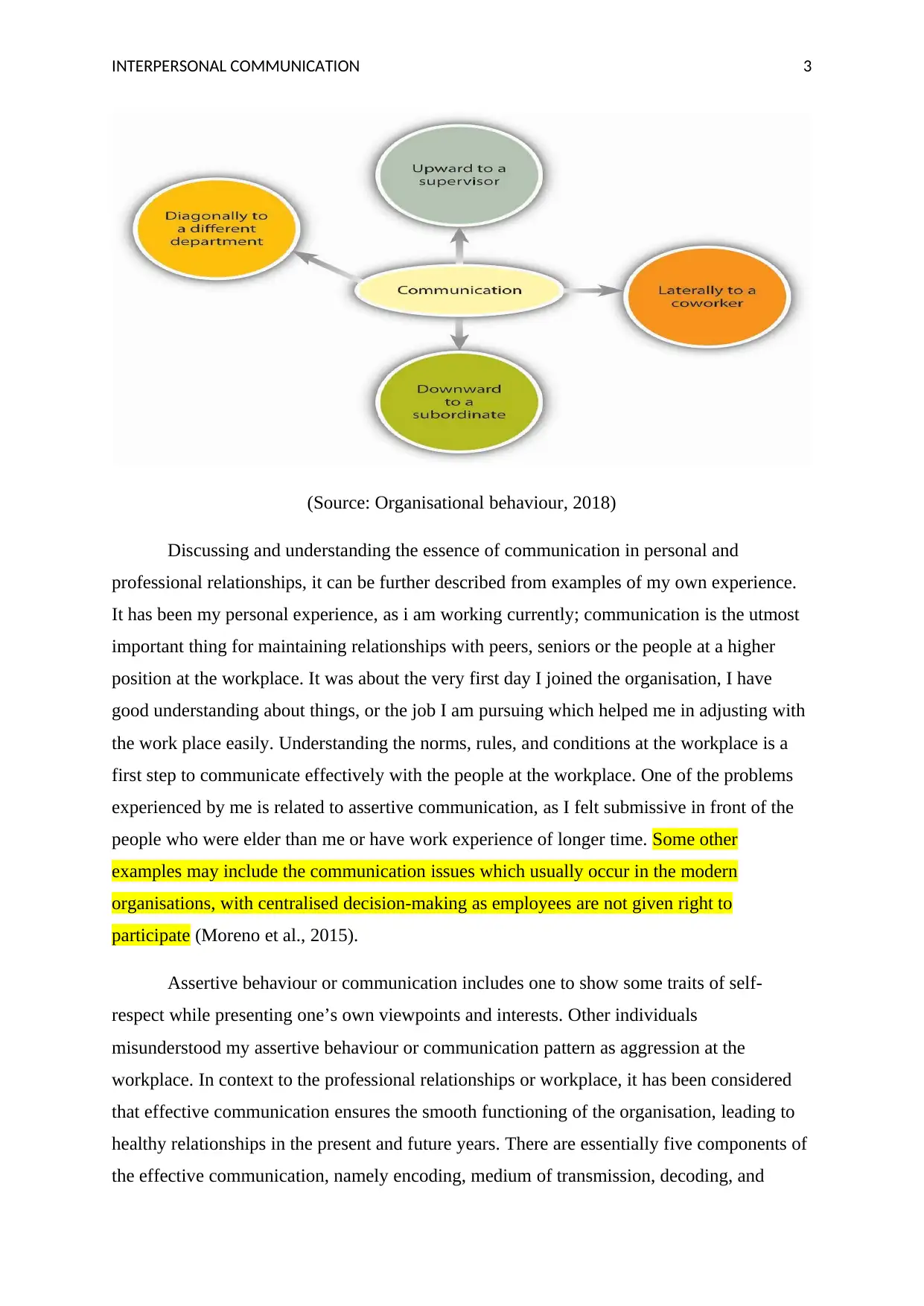
INTERPERSONAL COMMUNICATION 3
(Source: Organisational behaviour, 2018)
Discussing and understanding the essence of communication in personal and
professional relationships, it can be further described from examples of my own experience.
It has been my personal experience, as i am working currently; communication is the utmost
important thing for maintaining relationships with peers, seniors or the people at a higher
position at the workplace. It was about the very first day I joined the organisation, I have
good understanding about things, or the job I am pursuing which helped me in adjusting with
the work place easily. Understanding the norms, rules, and conditions at the workplace is a
first step to communicate effectively with the people at the workplace. One of the problems
experienced by me is related to assertive communication, as I felt submissive in front of the
people who were elder than me or have work experience of longer time. Some other
examples may include the communication issues which usually occur in the modern
organisations, with centralised decision-making as employees are not given right to
participate (Moreno et al., 2015).
Assertive behaviour or communication includes one to show some traits of self-
respect while presenting one’s own viewpoints and interests. Other individuals
misunderstood my assertive behaviour or communication pattern as aggression at the
workplace. In context to the professional relationships or workplace, it has been considered
that effective communication ensures the smooth functioning of the organisation, leading to
healthy relationships in the present and future years. There are essentially five components of
the effective communication, namely encoding, medium of transmission, decoding, and
(Source: Organisational behaviour, 2018)
Discussing and understanding the essence of communication in personal and
professional relationships, it can be further described from examples of my own experience.
It has been my personal experience, as i am working currently; communication is the utmost
important thing for maintaining relationships with peers, seniors or the people at a higher
position at the workplace. It was about the very first day I joined the organisation, I have
good understanding about things, or the job I am pursuing which helped me in adjusting with
the work place easily. Understanding the norms, rules, and conditions at the workplace is a
first step to communicate effectively with the people at the workplace. One of the problems
experienced by me is related to assertive communication, as I felt submissive in front of the
people who were elder than me or have work experience of longer time. Some other
examples may include the communication issues which usually occur in the modern
organisations, with centralised decision-making as employees are not given right to
participate (Moreno et al., 2015).
Assertive behaviour or communication includes one to show some traits of self-
respect while presenting one’s own viewpoints and interests. Other individuals
misunderstood my assertive behaviour or communication pattern as aggression at the
workplace. In context to the professional relationships or workplace, it has been considered
that effective communication ensures the smooth functioning of the organisation, leading to
healthy relationships in the present and future years. There are essentially five components of
the effective communication, namely encoding, medium of transmission, decoding, and
Paraphrase This Document
Need a fresh take? Get an instant paraphrase of this document with our AI Paraphraser
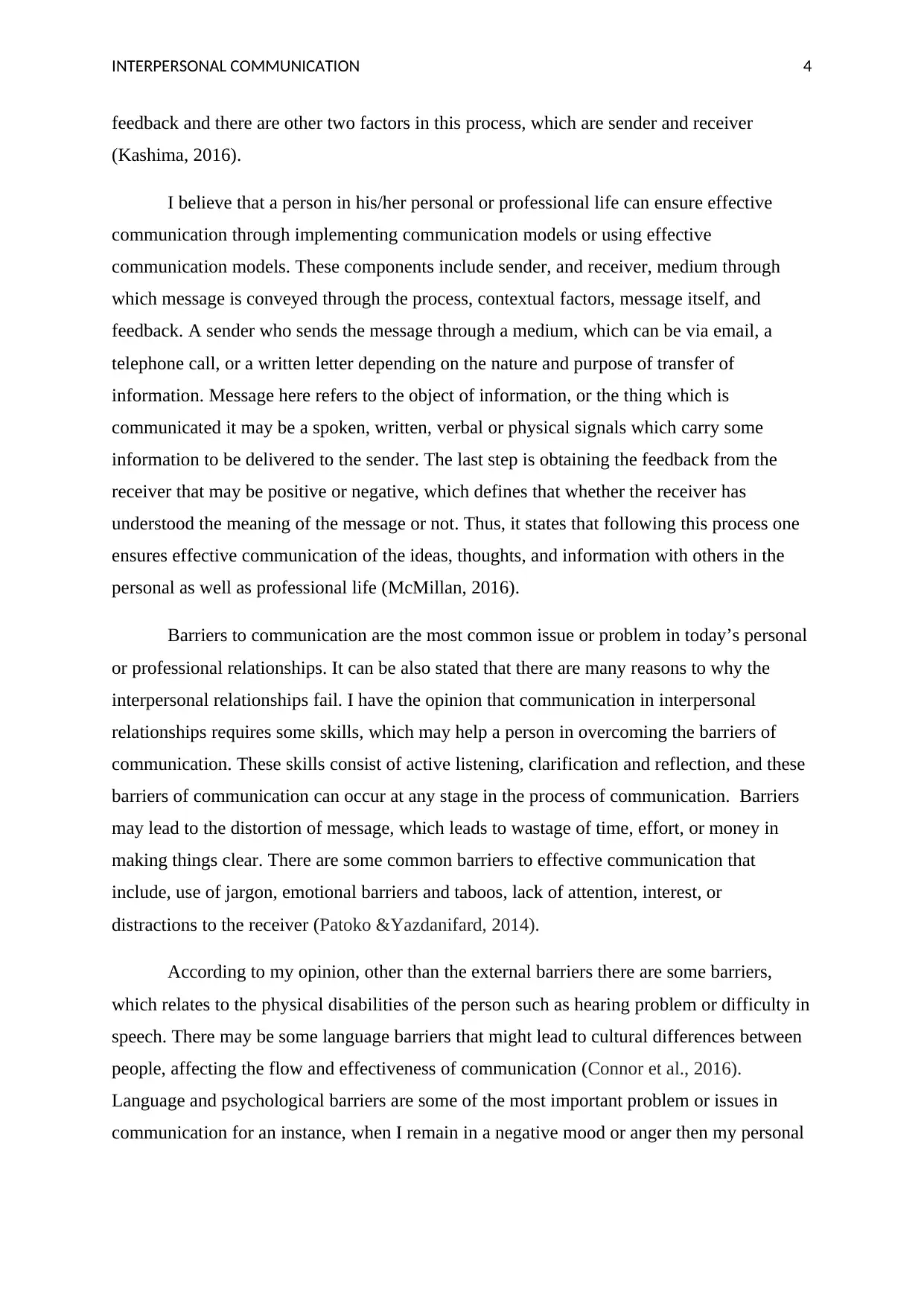
INTERPERSONAL COMMUNICATION 4
feedback and there are other two factors in this process, which are sender and receiver
(Kashima, 2016).
I believe that a person in his/her personal or professional life can ensure effective
communication through implementing communication models or using effective
communication models. These components include sender, and receiver, medium through
which message is conveyed through the process, contextual factors, message itself, and
feedback. A sender who sends the message through a medium, which can be via email, a
telephone call, or a written letter depending on the nature and purpose of transfer of
information. Message here refers to the object of information, or the thing which is
communicated it may be a spoken, written, verbal or physical signals which carry some
information to be delivered to the sender. The last step is obtaining the feedback from the
receiver that may be positive or negative, which defines that whether the receiver has
understood the meaning of the message or not. Thus, it states that following this process one
ensures effective communication of the ideas, thoughts, and information with others in the
personal as well as professional life (McMillan, 2016).
Barriers to communication are the most common issue or problem in today’s personal
or professional relationships. It can be also stated that there are many reasons to why the
interpersonal relationships fail. I have the opinion that communication in interpersonal
relationships requires some skills, which may help a person in overcoming the barriers of
communication. These skills consist of active listening, clarification and reflection, and these
barriers of communication can occur at any stage in the process of communication. Barriers
may lead to the distortion of message, which leads to wastage of time, effort, or money in
making things clear. There are some common barriers to effective communication that
include, use of jargon, emotional barriers and taboos, lack of attention, interest, or
distractions to the receiver (Patoko &Yazdanifard, 2014).
According to my opinion, other than the external barriers there are some barriers,
which relates to the physical disabilities of the person such as hearing problem or difficulty in
speech. There may be some language barriers that might lead to cultural differences between
people, affecting the flow and effectiveness of communication (Connor et al., 2016).
Language and psychological barriers are some of the most important problem or issues in
communication for an instance, when I remain in a negative mood or anger then my personal
feedback and there are other two factors in this process, which are sender and receiver
(Kashima, 2016).
I believe that a person in his/her personal or professional life can ensure effective
communication through implementing communication models or using effective
communication models. These components include sender, and receiver, medium through
which message is conveyed through the process, contextual factors, message itself, and
feedback. A sender who sends the message through a medium, which can be via email, a
telephone call, or a written letter depending on the nature and purpose of transfer of
information. Message here refers to the object of information, or the thing which is
communicated it may be a spoken, written, verbal or physical signals which carry some
information to be delivered to the sender. The last step is obtaining the feedback from the
receiver that may be positive or negative, which defines that whether the receiver has
understood the meaning of the message or not. Thus, it states that following this process one
ensures effective communication of the ideas, thoughts, and information with others in the
personal as well as professional life (McMillan, 2016).
Barriers to communication are the most common issue or problem in today’s personal
or professional relationships. It can be also stated that there are many reasons to why the
interpersonal relationships fail. I have the opinion that communication in interpersonal
relationships requires some skills, which may help a person in overcoming the barriers of
communication. These skills consist of active listening, clarification and reflection, and these
barriers of communication can occur at any stage in the process of communication. Barriers
may lead to the distortion of message, which leads to wastage of time, effort, or money in
making things clear. There are some common barriers to effective communication that
include, use of jargon, emotional barriers and taboos, lack of attention, interest, or
distractions to the receiver (Patoko &Yazdanifard, 2014).
According to my opinion, other than the external barriers there are some barriers,
which relates to the physical disabilities of the person such as hearing problem or difficulty in
speech. There may be some language barriers that might lead to cultural differences between
people, affecting the flow and effectiveness of communication (Connor et al., 2016).
Language and psychological barriers are some of the most important problem or issues in
communication for an instance, when I remain in a negative mood or anger then my personal
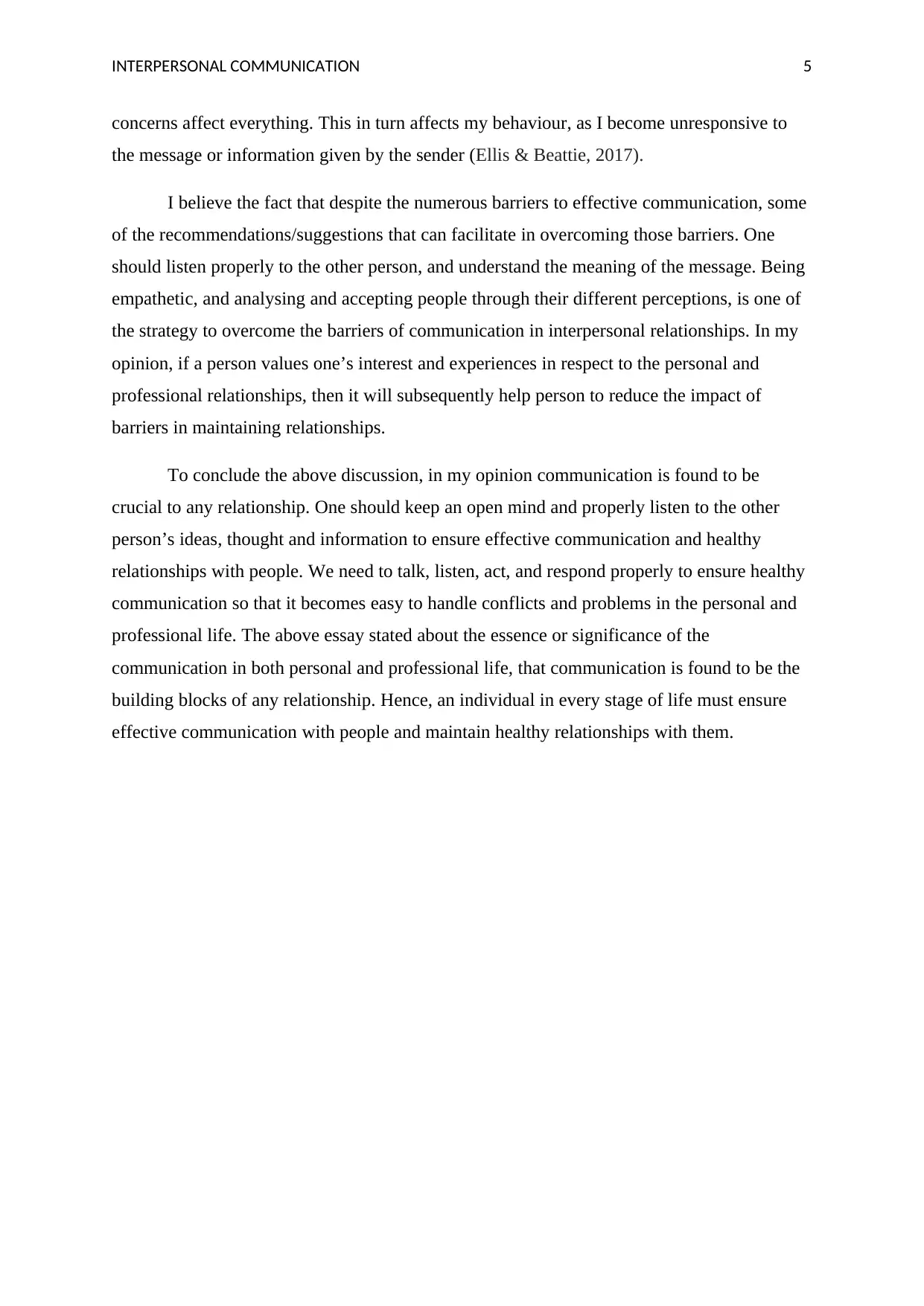
INTERPERSONAL COMMUNICATION 5
concerns affect everything. This in turn affects my behaviour, as I become unresponsive to
the message or information given by the sender (Ellis & Beattie, 2017).
I believe the fact that despite the numerous barriers to effective communication, some
of the recommendations/suggestions that can facilitate in overcoming those barriers. One
should listen properly to the other person, and understand the meaning of the message. Being
empathetic, and analysing and accepting people through their different perceptions, is one of
the strategy to overcome the barriers of communication in interpersonal relationships. In my
opinion, if a person values one’s interest and experiences in respect to the personal and
professional relationships, then it will subsequently help person to reduce the impact of
barriers in maintaining relationships.
To conclude the above discussion, in my opinion communication is found to be
crucial to any relationship. One should keep an open mind and properly listen to the other
person’s ideas, thought and information to ensure effective communication and healthy
relationships with people. We need to talk, listen, act, and respond properly to ensure healthy
communication so that it becomes easy to handle conflicts and problems in the personal and
professional life. The above essay stated about the essence or significance of the
communication in both personal and professional life, that communication is found to be the
building blocks of any relationship. Hence, an individual in every stage of life must ensure
effective communication with people and maintain healthy relationships with them.
concerns affect everything. This in turn affects my behaviour, as I become unresponsive to
the message or information given by the sender (Ellis & Beattie, 2017).
I believe the fact that despite the numerous barriers to effective communication, some
of the recommendations/suggestions that can facilitate in overcoming those barriers. One
should listen properly to the other person, and understand the meaning of the message. Being
empathetic, and analysing and accepting people through their different perceptions, is one of
the strategy to overcome the barriers of communication in interpersonal relationships. In my
opinion, if a person values one’s interest and experiences in respect to the personal and
professional relationships, then it will subsequently help person to reduce the impact of
barriers in maintaining relationships.
To conclude the above discussion, in my opinion communication is found to be
crucial to any relationship. One should keep an open mind and properly listen to the other
person’s ideas, thought and information to ensure effective communication and healthy
relationships with people. We need to talk, listen, act, and respond properly to ensure healthy
communication so that it becomes easy to handle conflicts and problems in the personal and
professional life. The above essay stated about the essence or significance of the
communication in both personal and professional life, that communication is found to be the
building blocks of any relationship. Hence, an individual in every stage of life must ensure
effective communication with people and maintain healthy relationships with them.
⊘ This is a preview!⊘
Do you want full access?
Subscribe today to unlock all pages.

Trusted by 1+ million students worldwide
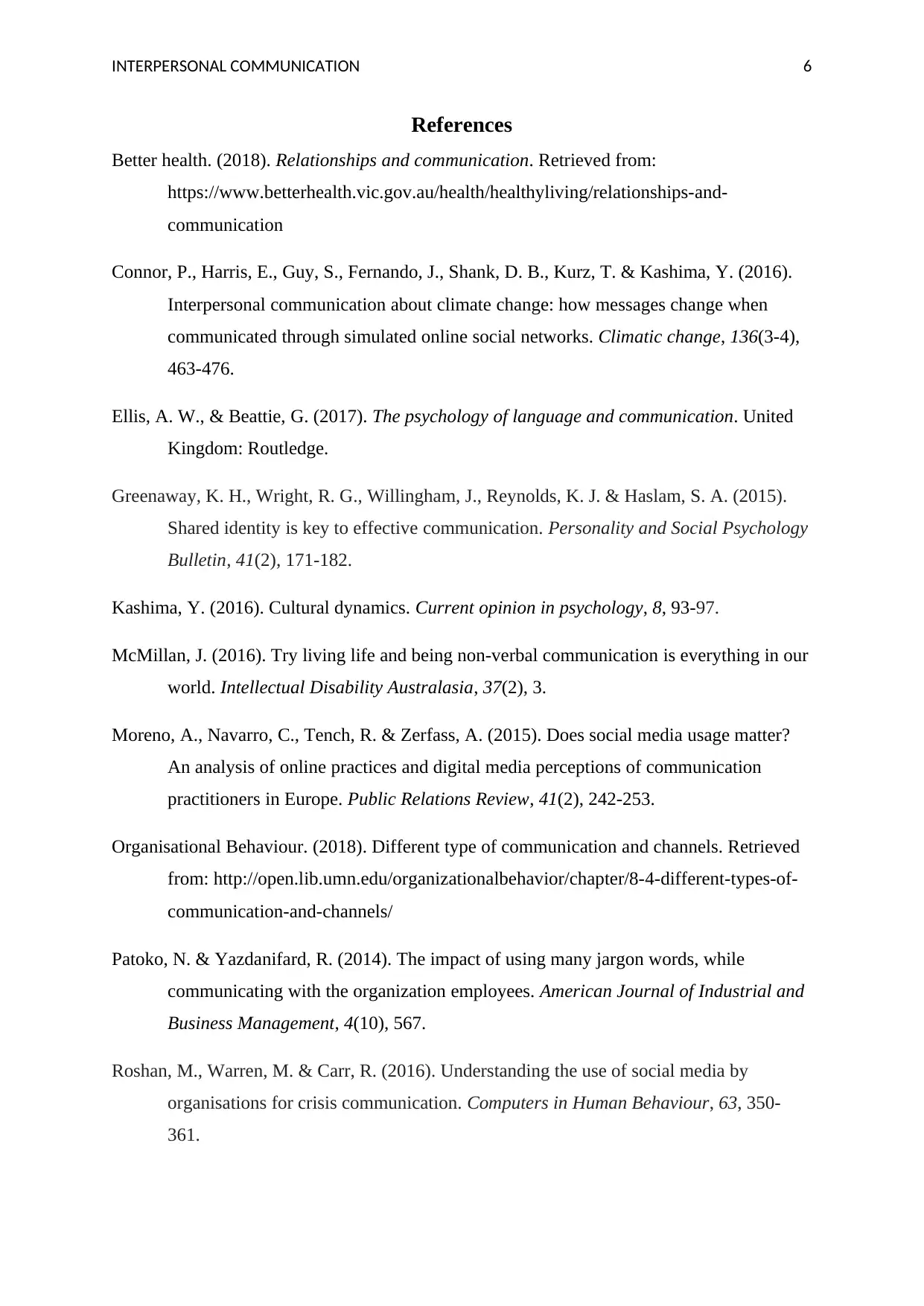
INTERPERSONAL COMMUNICATION 6
References
Better health. (2018). Relationships and communication. Retrieved from:
https://www.betterhealth.vic.gov.au/health/healthyliving/relationships-and-
communication
Connor, P., Harris, E., Guy, S., Fernando, J., Shank, D. B., Kurz, T. & Kashima, Y. (2016).
Interpersonal communication about climate change: how messages change when
communicated through simulated online social networks. Climatic change, 136(3-4),
463-476.
Ellis, A. W., & Beattie, G. (2017). The psychology of language and communication. United
Kingdom: Routledge.
Greenaway, K. H., Wright, R. G., Willingham, J., Reynolds, K. J. & Haslam, S. A. (2015).
Shared identity is key to effective communication. Personality and Social Psychology
Bulletin, 41(2), 171-182.
Kashima, Y. (2016). Cultural dynamics. Current opinion in psychology, 8, 93-97.
McMillan, J. (2016). Try living life and being non-verbal communication is everything in our
world. Intellectual Disability Australasia, 37(2), 3.
Moreno, A., Navarro, C., Tench, R. & Zerfass, A. (2015). Does social media usage matter?
An analysis of online practices and digital media perceptions of communication
practitioners in Europe. Public Relations Review, 41(2), 242-253.
Organisational Behaviour. (2018). Different type of communication and channels. Retrieved
from: http://open.lib.umn.edu/organizationalbehavior/chapter/8-4-different-types-of-
communication-and-channels/
Patoko, N. & Yazdanifard, R. (2014). The impact of using many jargon words, while
communicating with the organization employees. American Journal of Industrial and
Business Management, 4(10), 567.
Roshan, M., Warren, M. & Carr, R. (2016). Understanding the use of social media by
organisations for crisis communication. Computers in Human Behaviour, 63, 350-
361.
References
Better health. (2018). Relationships and communication. Retrieved from:
https://www.betterhealth.vic.gov.au/health/healthyliving/relationships-and-
communication
Connor, P., Harris, E., Guy, S., Fernando, J., Shank, D. B., Kurz, T. & Kashima, Y. (2016).
Interpersonal communication about climate change: how messages change when
communicated through simulated online social networks. Climatic change, 136(3-4),
463-476.
Ellis, A. W., & Beattie, G. (2017). The psychology of language and communication. United
Kingdom: Routledge.
Greenaway, K. H., Wright, R. G., Willingham, J., Reynolds, K. J. & Haslam, S. A. (2015).
Shared identity is key to effective communication. Personality and Social Psychology
Bulletin, 41(2), 171-182.
Kashima, Y. (2016). Cultural dynamics. Current opinion in psychology, 8, 93-97.
McMillan, J. (2016). Try living life and being non-verbal communication is everything in our
world. Intellectual Disability Australasia, 37(2), 3.
Moreno, A., Navarro, C., Tench, R. & Zerfass, A. (2015). Does social media usage matter?
An analysis of online practices and digital media perceptions of communication
practitioners in Europe. Public Relations Review, 41(2), 242-253.
Organisational Behaviour. (2018). Different type of communication and channels. Retrieved
from: http://open.lib.umn.edu/organizationalbehavior/chapter/8-4-different-types-of-
communication-and-channels/
Patoko, N. & Yazdanifard, R. (2014). The impact of using many jargon words, while
communicating with the organization employees. American Journal of Industrial and
Business Management, 4(10), 567.
Roshan, M., Warren, M. & Carr, R. (2016). Understanding the use of social media by
organisations for crisis communication. Computers in Human Behaviour, 63, 350-
361.
Paraphrase This Document
Need a fresh take? Get an instant paraphrase of this document with our AI Paraphraser
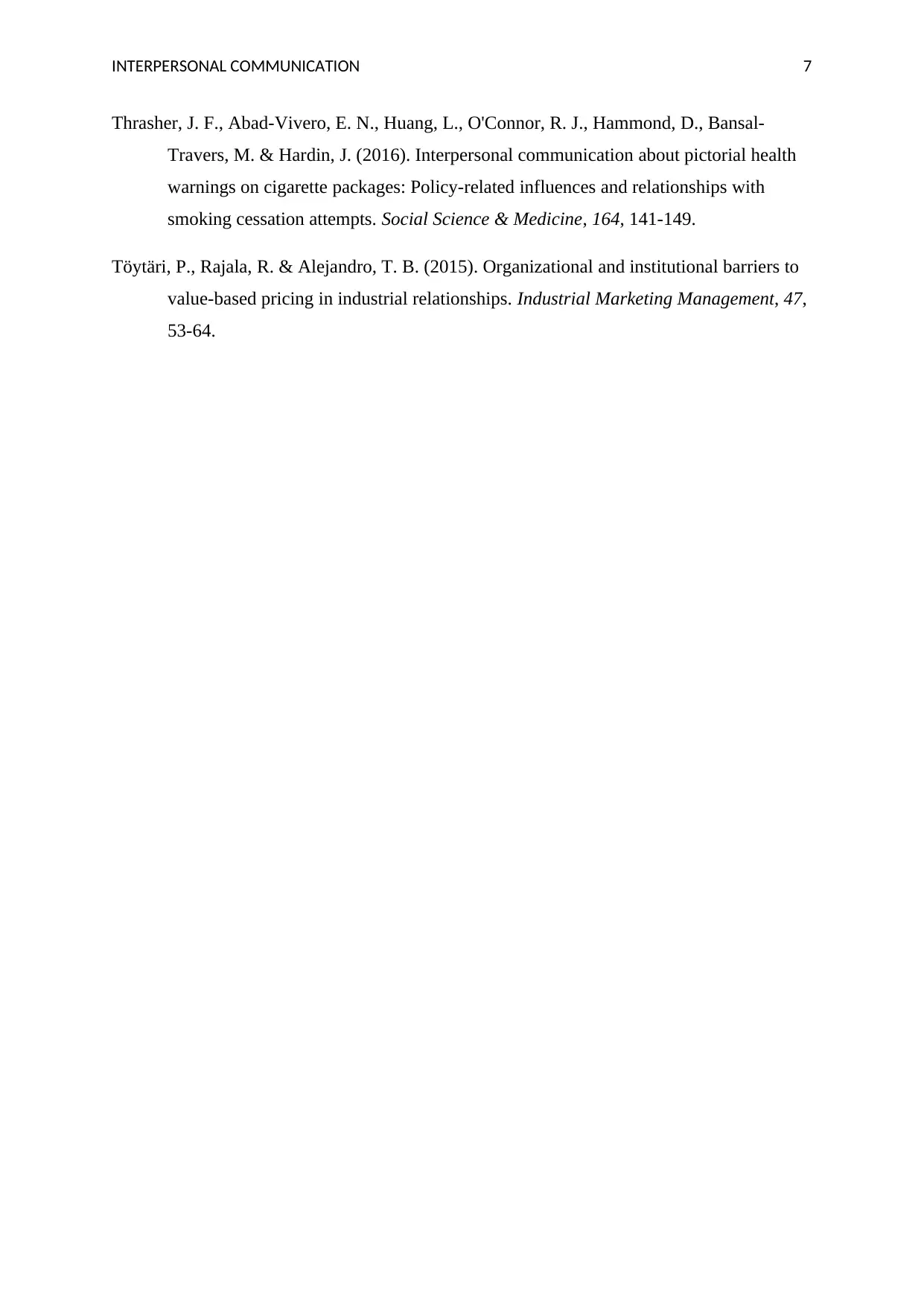
INTERPERSONAL COMMUNICATION 7
Thrasher, J. F., Abad-Vivero, E. N., Huang, L., O'Connor, R. J., Hammond, D., Bansal-
Travers, M. & Hardin, J. (2016). Interpersonal communication about pictorial health
warnings on cigarette packages: Policy-related influences and relationships with
smoking cessation attempts. Social Science & Medicine, 164, 141-149.
Töytäri, P., Rajala, R. & Alejandro, T. B. (2015). Organizational and institutional barriers to
value-based pricing in industrial relationships. Industrial Marketing Management, 47,
53-64.
Thrasher, J. F., Abad-Vivero, E. N., Huang, L., O'Connor, R. J., Hammond, D., Bansal-
Travers, M. & Hardin, J. (2016). Interpersonal communication about pictorial health
warnings on cigarette packages: Policy-related influences and relationships with
smoking cessation attempts. Social Science & Medicine, 164, 141-149.
Töytäri, P., Rajala, R. & Alejandro, T. B. (2015). Organizational and institutional barriers to
value-based pricing in industrial relationships. Industrial Marketing Management, 47,
53-64.
1 out of 8
Related Documents
Your All-in-One AI-Powered Toolkit for Academic Success.
+13062052269
info@desklib.com
Available 24*7 on WhatsApp / Email
![[object Object]](/_next/static/media/star-bottom.7253800d.svg)
Unlock your academic potential
Copyright © 2020–2025 A2Z Services. All Rights Reserved. Developed and managed by ZUCOL.



